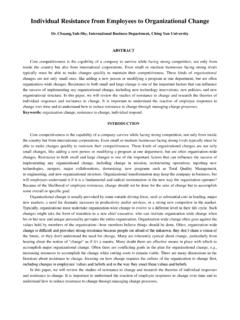Transcription of Why Transformation Efforts Fail - IPLS
1 VER THE PAST DECADE,I have watched more than 100 companies try to remake themselves into significantly better competitors. They have included large organiza-tions (Ford) and small ones (Landmark Communications),companies based in the United States (General Motors) and else-where (British Airways), corporations that were on their knees(Eastern Airlines), and companies that were earning good money(Bristol-Myers Squibb). These Efforts have gone under many ban-ners: total quality management, reengineering, rightsizing, re-structuring, cultural change , and turnaround.
2 But, in almostevery case, the basic goal has been the same: to make fundamen-tal changes in how business is conducted in order to help copewith a new, more challenging market few of these corporate change Efforts have been very suc-cessful. A few have been utter failures. Most fall somewhere in be-tween, with a distinct tilt toward the lower end of the scale. Thelessons that can be drawn are interesting and will probably be rel-evant to even more organizations in the increasingly competitiveOLeading change Why Transformation Efforts fail Leaders who successfully transform businesses do eight things right (and they do them in the right order).
3 By John P. KotterEditor s Note: Guiding change may be the ultimate test of a leader no businesssurvives over the long term if it can t reinvent itself. But, human nature beingwhat it is, fundamental change is often resisted mightily by the people it mostaffects: those in the trenches of the business. Thus, leading change is bothabsolutely essential and incredibly nobody understands the anatomy of organizational change betterthan retired Harvard Business School professor John P. Kotter. This article,originally published in the spring of 1995, previewed Kotter s 1996 book outlines eight critical success factors from establishing a sense ofextraordinary urgency, to creating short-term wins, to changing the culture ( theway we do things around here ).
4 It will feel familiar when you read it, in partbecause Kotter s vocabulary has entered the lexicon and in part because itcontains the kind of home truths that we recognize, immediately, as if we dalways known them. A decade later, his work on leading change remainsdefinitive. THE TESTS OF A LEADER|BEST OF HBR|199596 Harvard Business Review |January 2007 | |January 2007 |Harvard Business Review 97business environment of the most general lesson to belearned from the more successful casesis that the change process goes througha series of phases that, in total, usuallyrequire a considerable length of steps creates only the illusionof speed and never produces a satisfy-ing result.
5 A second very general lessonis that critical mistakes in any of thephases can have a devastating impact,slowing momentum and negating hard-won gains. Perhaps because we haverelatively little experience in renewingorganizations, even very capable peopleoften make at least one big 1:Not Establishing a GreatEnough Sense of UrgencyMost successful change Efforts beginwhen some individuals or some groupsstart to look hard at a company s com-petitive situation, market position, tech-nological trends, and financial perfor-mance. They focus on the potentialrevenue drop when an important pat-ent expires, the five-year trend in declin-ing margins in a core business, or anemerging market that everyone seemsto be ignoring.
6 They then find ways tocommunicate this information broadlyand dramatically, especially with re-spect to crises, potential crises, or greatopportunities that are very timely. Thisfirst step is essential because just get-ting a Transformation program startedrequires the aggressive cooperation ofmany individuals. Without motivation,people won t help, and the effort with other steps in thechange process, phase one can soundeasy. It is not. Well over 50%of the com-panies I have watched fail in this firstphase. What are the reasons for thatfailure?
7 Sometimes executives under-estimate how hard it can be to drivepeople out of their comfort they grossly overestimatehow successful they have already beenin increasing urgency. Sometimes theylack patience: Enough with the prelim-inaries; let s get on with it. In manycases, executives become paralyzed bythe downside possibilities. They worrythat employees with seniority will be-come defensive, that morale will drop,that events will spin out of control, thatshort-term business results will be jeop-ardized, that the stock will sink, andthat they will be blamed for creatinga paralyzed senior managementoften comes from having too manymanagers and not enough s mandate is to mini-mize risk and to keep the current sys-tem operating.
8 change , by definition,requires creating a new system, whichin turn always demands one in a renewal process typi-cally goes nowhere until enough realleaders are promoted or hired into senior-level often begin, andbegin well, when an organization has anew head who is a good leader and whosees the need for a major change . If therenewal target is the entire company,the CEO is key. If change is needed in adivision, the division general manageris key. When these individuals are notLawrence Zeegennew leaders, great leaders, or changechampions, phase one can be a business results are both a bless-ing and a curse in the first phase.
9 On thepositive side, losing money does catchpeople s attention. But it also gives lessmaneuvering room. With good businessresults, the opposite is true: Convincingpeople of the need for change is muchharder, but you have more resources tohelp make whether the starting point isgood performance or bad, in the moresuccessful cases I have witnessed, an individual or a group always facilitatesa frank discussion of potentially un-pleasant facts about new competition,shrinking margins, decreasing marketshare, flat earnings, a lack of revenuegrowth, or other relevant indices of adeclining competitive position.
10 Becausethere seems to be an almost universalhuman tendency to shoot the bearer ofbad news, especially if the head of theorganization is not a change champion,executives in these companies oftenrely on outsiders to bring unwanted in-formation. Wall Street analysts, custom-ers, and consultants can all be helpfulin this regard. The purpose of all this ac-tivity, in the words of one former CEOof a large European company, is tomake the status quo seem more danger-ous than launching into the unknown. In a few of the most successful cases,a group has manufactured a crisis.









